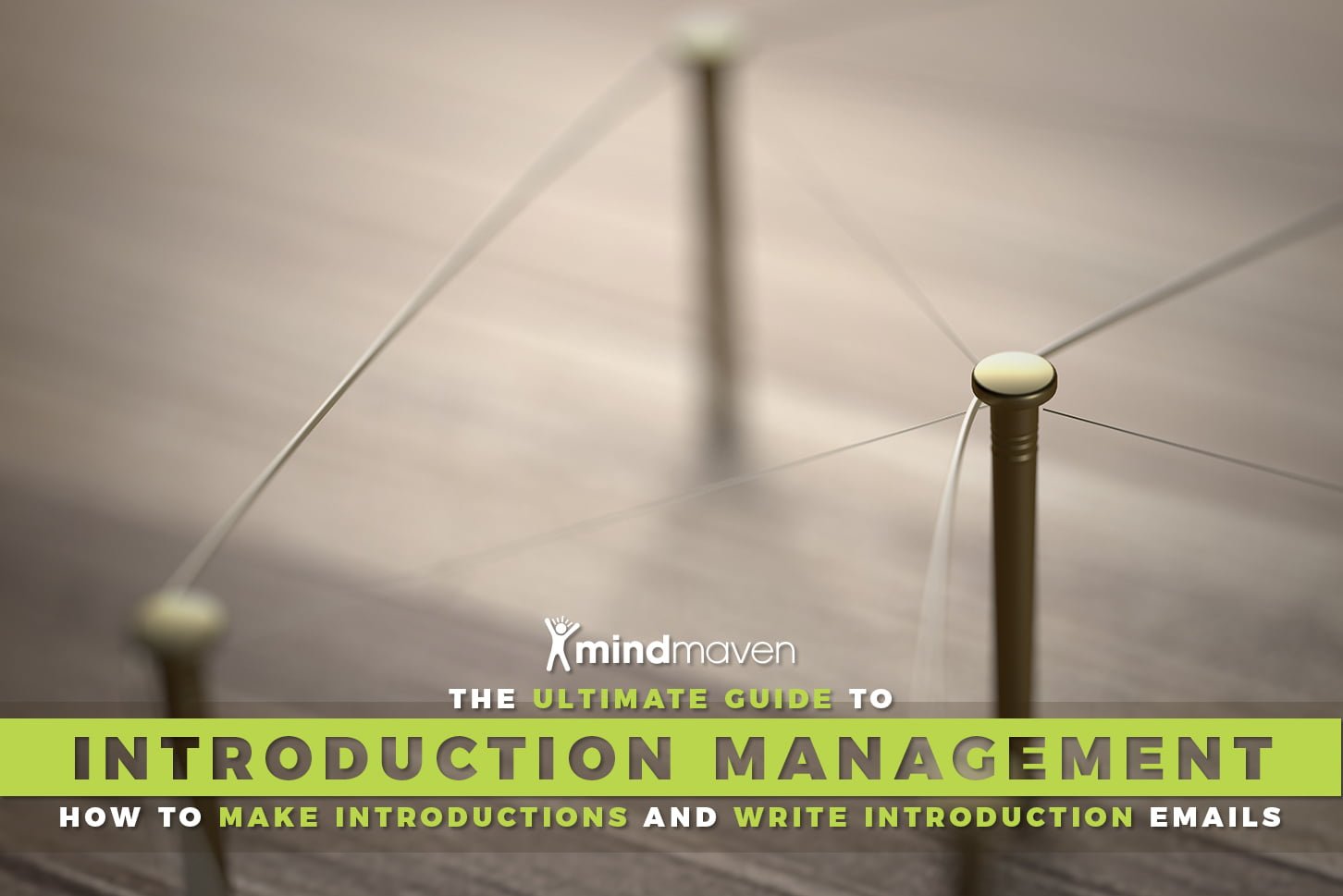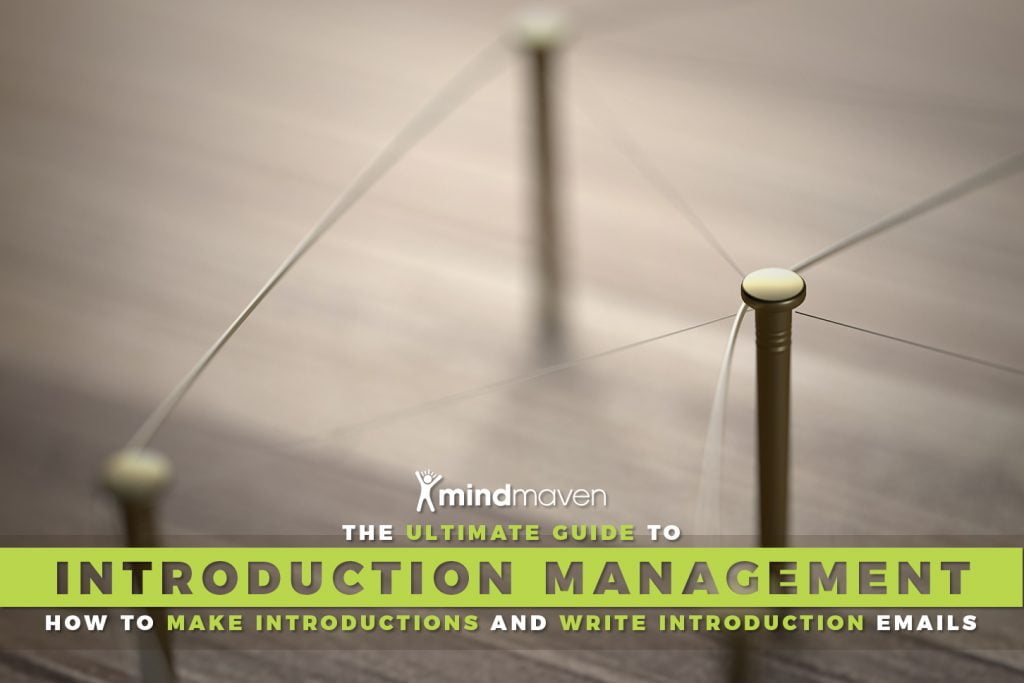
Imagine this: You’ve just met with a new contact for the first time and can already tell there’s a lot of potential in the relationship.
As a result, you want to establish yourself as someone of value; someone worth connecting with. What’s one of the most effective ways to deliver this kind of value early in a relationship?
Simple: By offering a professional introduction.
But you need to know not only how to make introductions, but how to make introductions that deliver massive value to your network. Doing so is more simple than you may think …
Almost any new contact you meet would benefit from an introduction to someone you know; and offering to bridge that gap can be a powerful way to provide a meaningful, relevant, valuable interaction. But if business introductions are so powerful, why don’t we do them more often?
Because introductions come with a pretty hefty tax. Although the concept is simple, doing the process right is surprisingly complex. Not only does making an introduction require a substantial amount of time, it also demands a good deal of your brain’s processing power to determine how to make introductions.
Because at the end of the day, making an introduction is a lot more than sending a single email to connect two people. Here’s how to make introductions in five easy phases:
- The validation phase,
- The opt-in phase,
- The follow-up phase,
- The introduction phase, and
- The wrap-up phase.
Let’s take a closer look at each of these phases and talk about how to make introductions that deliver as much value to your network as possible.
Phase one: Validation
Generally speaking, there are three types of business introductions:
- Those you shouldn’t make because they aren’t relevant or valuable enough,
- Those that are difficult to make because the relevance or value isn’t immediately apparent, and
- Those that are easy to make because the relevance and value to both parties is immediately apparent.
In most cases, my recommendation is to focus on that third category: The easy introductions. Why? Because they’re usually going to be more valuable for both parties, and more efficient for you.
These types of introductions often have a much higher likelihood of being accepted (see phase two below), a better response rate, and a dramatically higher velocity.
But how do you ensure an introduction is going to be valuable to both parties in advance? That all starts with knowing your network.
Validate the introduction by asking yourself: “Do I truly know what each party wants right now? And does this introduction align with those needs? If so, how?”
If the answer’s “yes,” make the introduction. But if the answers “no,” you’ll probably want to hold off. Remember: Just because you can make a professional introduction—or just because someone asks for an introduction—doesn’t mean you have to make one.
Warning: Don’t be a Super Connector
If you make every potential introduction without a thought to relevance and value, you become what’s known as a Super Connector; and in most cases, that’s not a good thing.
Super Connectors are those who become inflationary in the way they make introductions. As a result, their introductions often feel mindless, transactional, and compulsive; as if the introducer is hoping to generate value by sheer quantity, rather than quality.
Always ensure both parties will receive measurable value out of an introduction before you offer or accept it.
Phase Two: Opt-in
One of the most common introduction management mistakes is failing to opt both parties into the exchange. In other words, you have to ensure both parties want the introduction in the first place.
Too often, we’re so eager to provide value to a new contact that we promise an introduction to someone without ever confirming this “someone” is even interested in the introduction.
For example, imagine you received an unexpected email that looked something like this:
Hey [your name],
Meet John. I think the two of you have a lot in common and would really benefit from meeting one another. I promised John I’d make this introduction, so I’ll let you guys take it from here!
How likely would you be to appreciate—or even respond—to an email like that? Probably not very. Why? Because the email’s got two primary problems:
- First off, they didn’t ask your permission for the introduction.
- Secondly, they didn’t provide any context about why the introduction might be relevant to you.
And yet, despite these problems, many people still try to make introductions this way. No surprise, many of them never end up coming to fruition.
But there’s a better way, and it starts with this: As a general rule, never commit to—or make—a business introduction until you have both party’s approval.
So instead of saying, “I know someone you’ve got to meet! I’ll introduce you this week,” try something like, “I think I know someone you’d benefit from meeting. I’ll reach out to her this week and see if she’s interested and available.”
Then all you’ve got to do is draft an opt-in email with enough context to intrigue the other person. For example:
Hi Erin,
I recently met Rapple’s John Smith. He’s thinking of stepping out of operations and into investing. I know this can be a tricky transition, and it’s one I admire you for doing so well.
You two share a similar history—and I know you’re looking to grow your investment team—so I think you’d both benefit from getting to know one another. Would you be interested in an introduction?
Begin the process this way and your introduction is much more likely to succeed and benefit all parties involved.
What If Someone Turns Down an Introduction Request?
Just because you offer an introduction doesn’t necessarily mean the other party wants the introduction, but that’s okay.
As long as you set realistic expectations (as illustrated above with, ” … I’ll see if she’s interested and available …”), it’s easy to go back and let the other person know the introduction isn’t going to happen.
Because when someone turns down an introduction, they often let you know why. For example, they’re …
- Too busy,
- Only taking recruiting calls, or
- Focused solely on their current project.
All you have to do is relay that information and you’ll still win; because a big part of the perceived value comes from your intent, regardless of the outcome.
Quick tip: Receiving introduction offers you can’t fulfill? Here’s two great articles on how to say no without damaging the relationship.
Phase Three: Follow-up
You could write the most thought-out opt-in email in the world and still not hear back from the other party. Why is that?
Generally speaking, it’s not because they’re spiteful or uninterested; in many cases, no response simply means the other person got so caught up in the reactive urgency of day-to-day life that they just didn’t get around to responding. They probably saw the email, meant to reply, then got involved in something else and forgot.
That’s why it’s so important to follow-up.
No surprise, this is where the process often falls apart: You offer a potential introduction, send an opt-in email, and … Then life gets busy and you forget about it. Suddenly three weeks pass and you finally realize you never heard back.
And this is a huge problem, because there’s a good chance you’ve damaged your relationship with the person you offered the introduction to. By failing to follow through, you may have unintentionally communicated to this person that they aren’t worth your time.
All of this to say, you need some sort of system in place that reminds you to follow-up with unfulfilled opt-ins.
That’s why we at Mindmaven train our clients on a concept called LoopLeverage. Simply put, LoopLeverage helps you “close the loop” on open cycles, like unfulfilled commitments or opt-ins. Here’s how this might work in the context of how to make introductions:
- Step one: Send an opt-in email to John Smith, offering an introduction to Erin Roberts.
- Step two: Create a task—in the form of a question—in your task management solution; then set the due day for 72 hours in the future. For example: “Did I hear back from John Smith about the introduction to Erin Roberts?”
Here’s how this might look in our task management tool of choice, Asana:

- Step three: In 72 hours, your task management solution will prompt you to check whether or not you’ve heard back from John. And if you haven’t, you’ll know it’s time to draft a follow-up email.
If you have a good relationship with this person, a single follow-up email is usually all it takes. They’ll feel embarrassed about not getting back to you and will often reply on the spot; and as long as this person is invested in their relationship with you, they’re likely to agree to the introduction.
Phase Four: Introduction
Alright: You sent the opt-in, followed up, and got the confirmation. Now you’re finally ready to send the business introduction email. Many people assume this process is self-explanatory and, as a result, send emails that are way too short. For example:
Hey,
Here’s that introduction I promised. Since I’ve already talked to both of you individually, I’ll let you two take it from here.
That interaction’s shorter than some tweets! Sure, you connected them; but you provided no context. By the time they actually connect in the next two or three weeks, at least one of them has probably forgotten why the introduction is relevant in the first place.
If they have to spend more than a few minutes digging through their emails to find out why the introduction is relevant, they’re probably going to be a little annoyed. Or worse: Because the value isn’t immediately apparent, they may end up postponing the meeting.
You might save yourself a little time by writing a brief email, but all you end up doing is transferring the burden onto others. To make sure that doesn’t happen, let’s talk about how to make introductions by writing an effective professional email.
How To Make Introductions With a Great Business Introduction Email
We’ve already talked about what a bad introduction looks like, so let’s take a look at a good introduction:
Hi John and Erin,
I hope you’re both well. Here’s that introduction email I promised.
Erin, meet John. John is the founder and CEO at Rapple. I met John at the Post Seed conference a few years back. He’s a phenomenal operator and proven entrepreneur. In fact, he sold his most recent startup to Moogle and, prior to that, had two successful exits. He’s currently looking into investing into companies instead of running them, and has a few questions and concerns. Since you’ve voiced an interest in growing your team—and had a hugely successful transition from operator to investor—I immediately thought of you.
John, Meet Erin. Erin was one of my first clients and someone I’ve known for many years as a friend. She was the founder and CEO of Macrosoft for seven years before venturing into investing. She now has her own firm, and I’m confident she can answer many of the questions you have.
I really think the two of you are going to enjoy getting to know one another. You come from similar walks of life and share many of the same viewpoints on the importance of family and the role of a leader in a business.
I hope you two can connect, and I’ll let you take it from here.
As you can see above, how to make introductions with an effective email accomplishes three primary things:
- It addresses each party individually,
- It briefly describes your history and relationship to each individual, and
- It predicts the positive experience both parties will enjoy as a result of the introduction.
Follow those guidelines on how to make introductions via email—or even copy and paste the template above—and the experiences you deliver as a result of your introductions will be richer, fuller, and more valuable to everyone involved.
Phase Five: Wrap-up
Many people make the mistake of assuming their role in how to make introductions is over as soon as the email’s been sent. It’s not.
Although the process of how to make introductions is largely focused on providing value to your network, there’s one final step you can take to maximize the value you gain from this experience, and it’s simple:
3-4 weeks after the introduction was made, reach out to both parties individually and ask whether or not they were able to connect and, if so, if anything valuable came from it.
Hopefully—and in most cases—they’ll have a positive experience to share. But either way, the simple fact that you’re checking in with them clearly displays three personal traits:
- That you have an extraordinary memory,
- That you truly care about the people in your network, and
- That you’re really “on top of things” and take care of business.
Those three traits are foundational to high-performers; you’ll rarely find someone with any lasting success who doesn’t personify them.
So when the most important people in your network start associating those traits to you, they’ll also start associating terms like “successful,” “trustworthy,” and “high-quality.”
Plus, if the introduction led to an exceptionally positive experience, this follow-up will also serve as a reminder that the interaction all started with you.
Four Final Tips to Supercharge How to Make Introductions
The concept of introducing two people is simple, but how to make introductions is anything but trivial. As we’ve already discussed, how to make introductions the right way involves a pretty significant time and mindshare tax; but doing it right is worth the effort.
That said, there are a few steps you can take to make the process of how to make introductions a little easier. For example …
#1: Create Templates
Most introductions will involve at least four emails: An opt-in email, a follow-up email, and an introduction email, and a wrap-up email. Although the exact wording for these emails will change on a case-by-case basis, their structure will likely remain the same.
Save yourself time by creating templates for each of those four emails. After all, it’s quicker to make a few modifications than it is to write an entire email from scratch.
However, you must use templates wisely. Think of them as a framework for a successful email, not the complete structure of one. Make sure you take the time to personalize the template for each introduction.
#2: Leverage Technology to Your Advantage
Even with templates and reminders, it’s often hard to make time for proactive tasks like introductions. Thankfully, entrepreneurs like Entro founder Seth Gold (@seth_gold) have created powerful technologies that makes the process a little easier.
Entro is an great web and mobile app designed to optimize and automate almost every step of the introduction process. Check it out if you find introductions often stuck in your pipeline.
#3: Streamline Introductions to Your MVPs
Many people find themselves sending introductions to the same 5-10 contacts over and over again. If that sounds like you, you can significantly improve the efficiency of these introductions by cutting out the opt-in phase. Here’s how it works:
Sit down with those you consistently send introductions to and ask them about their experience with your introductions so far. In particular, use this conversation to …
- Reaffirm that you understand what they want out of new introductions, and
- Ensure they’re receiving measurable value from the introductions you’ve sent them so far.
Assuming they’ve benefitted from your past introductions, ask for permission to send future introductions without the opt-in. This increases the velocity of all future introductions for everyone involved.
If they agree, you might also want to set up a few “code words” to use that rate new introductions on a scale from, “I pretty sure you’ll enjoy this introduction but not 100% positive,” to “I’m 100% certain this is a high-value introduction.”
For example: You might include the word “really” in especially valuable introductions (“I really think you’ll enjoy meeting Peter”) to communicate that this introduction is definitely worth their time.
And you might include the phrase “I’m confident” in those introductions that are a little more of a gamble (“I’m confident you’ll enjoy meeting Erin”) to communicate that you think the introduction will be valuable, but that you could be wrong.
This simple process will dramatically increase the efficiency of how to make introductions with this contact for the future.
#4: Work With an Engagement Manager
If you find yourself wanting to make more introductions but would prefer to just click “send” on already-written emails, you need more leverage; and the best way to do that is by working with an Engagement Manager.
Put simply, an Engagement Manager (EM) is an assistant trained specifically to help you deliver more value to and receive more value from your network. In addition to a host of other skills, they’re fully trained to personally handle every part of the introduction process; from drafting emails to following up on reminders.
Click here to learn more about working with an EM.
If you consistently follow through on the tips in this post on how to make introductions, you’re going to do more than simply learn how to make introductions; you’re going to deliver experiences.
And as I always say: Experiences become stories. Stories become legends. And legends create legendary leaders.


